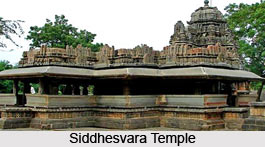 Siddhesvara Temple was built in the 12th century and is known for many sculptures of Hindu deities. The temple faces west which is unusual in Chalukyan constructions. Presently the presiding deity is Lord Shiva. However, there is an uncertainty regarding the main deity of the temple due to the many loose sculptures that exist in it. The temple is built of soapstone.
Siddhesvara Temple was built in the 12th century and is known for many sculptures of Hindu deities. The temple faces west which is unusual in Chalukyan constructions. Presently the presiding deity is Lord Shiva. However, there is an uncertainty regarding the main deity of the temple due to the many loose sculptures that exist in it. The temple is built of soapstone.
On the eastern wall of the temple image of the Sun God exists below the little Kirtimukhas. Image of Shiva is sculpted out of an independent slab of stone and mounted in front of the Sikhara above the mandapa roof. The temple plan bears all the hallmarks of a standard 11th century Chalukyan construction with some innovative elements of 12th century. It has miniature decorative towers on pilasters.
Architecture and Sculpture of Siddhesvara Temple
The mandapa in the temple contains sculptures of Uma Mahesvara, Lord Vishnu and Goddess Lakshmi, the Sun God, Naga-Nagini, Lord Ganesha and Kartikeya. Shiva is depicted with four arms, holding the damaru, the aksamala and the trishul in three arms. The sculpture of Uma is well decorated with garlands, large earrings and curly hair. The Naga and Nagini, with their tails intertwined, appear on the side of the door to the vestibule (antechamber) along with an image of Goddess Parvati. A niche depicts a curious male figure with six hands, the two lower hands each hold a linga (the symbol of Shiva) and the middle left hand holds a chakra (wheel).
The architrave above the vestibule entrance bears images of Brahma, Shiva and Vishnu, with Shiva in the centre. Ganapati and Kartikeya flank Brahma and Vishnu. On either side of the doorway is a perforated stone worked window. Some ceiling panels contain images of the Sapta Matrikas. There is a square column that contains images of the ashtadikpalas along with the Hindu trinity and Surya. The saptamatrikas are carved into the wall. Next to Shiva are the Matrika (mother) goddesses. Other loose sculptures worth mentioning are those of Surya canopied by a seven hooded snake, and the Mahishasuramardini. The temple premises have several inscriptions.





















